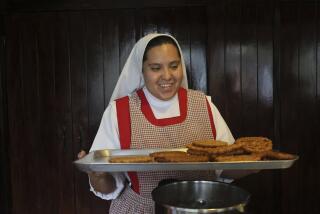Doing the dirty work for Ash Wednesday
Some churches abandoned the practice because of the fire danger. Some responded to air quality laws.
At Our Mother of Good Counsel Church, a parishioner who for years made the ashes for Ash Wednesday died in the 1980s -- and so did the parish’s practice of burning fronds from the previous Palm Sunday for the centuries-old rite.
So Our Mother of Good Counsel, like churches all over the country, began ordering ashes from a church supply store. Some churches buy them in person, others on the Internet.
“It’s just a lot easier and safer for most churches,” said Father Tom Behan, who has served off and on at the Los Feliz parish for 40 years. “It’s what Ash Wednesday means that matters.”
Ash Wednesday, which this year falls on Feb. 21, is a day of penance marking the beginning of Lent for Western Christian churches.
Roman Catholic, Anglican and, increasingly, some Protestant churches hold special services at which churchgoers’ foreheads are marked with palm ash as a symbol of death and sorrow for sin.
The Catholic practice dates to the 12th century, said Father Dorian Llywelyn, assistant professor of theology at Loyola Marymount University.
The symbolism of ashes has roots in the Jewish traditions of antiquity, when people would wear burlap and mark their foreheads with ashes as a sign of grief and repentance, he said.
“It’s an outward sign of inner spirituality,” Llywelyn said. “It’s a reminder of our mortality, and that’s something in Hollywood we tend to forget, with the cult of youth and plastic surgery.”
In the Book of Genesis, God chastises Adam and Eve for committing their first sin, reminding them of their mortality by saying, “For dust you are and to dust you will return.”
It’s the phrase ministers or priests have commonly recited while marking worshipers’ foreheads with ashes. But Llywelyn said now Catholic churches often say, “Turn away from sin and believe the Gospel.”
“It’s more of a positive spin, more to encourage you than frighten you,” Llywelyn said.
The change in wording, like the move to buying ashes, reflects how churches adapt their practices over time, he said.
In the United States, commercial palm ash makers are based in Texas and Florida and ship the ash all over the country, along with decorative fronds used in Palm Sunday services.
The ashes are packed in canisters or in sandwich bags. One ounce, which can bless 250 people, typically sells for $3.50.
“We provide ashes as a service to churches that are too small to make their own,” said Daniel Castonguay, owner of Abbott Church Goods, a New Jersey-based business that orders its ash from Texas.
“The majority of our customers, which are in New England, don’t have a lot of palm trees around either.”
Like Abbott, Rhode Island-based Tally’s Church Supplies started selling ashes about 20 years ago and initially tried to make its own. After a few tries, though, Tally’s gave up.
“We stopped making them because of the difficulty involved,” said Tom Tally, one of the managers of his family’s 128-year-old business.
Tally said he couldn’t estimate how many congregations use his ashes but said, “Some churches stock up on it.” Noting that fresh green fronds will wither with age, he added, “While palms go bad, the ashes don’t.”
Tally’s ships about 250 of its 2-ounce bags each year. The store orders its ashes from Higginbotham & Sons, a supplier in Mims, Fla., near Orlando.
“It takes a lot of palm to make a little bit of ash,” said Ralph M. Higginbotham, the supplier’s 82-year-old owner. “It’s a pretty messy job. You’re completely covered in black when you’re done.”
Higginbotham mainly sells palm fronds but has sold ash, at about $22.50 a pound, for 20 years.
He usually sells 300 pounds of ash annually to about 100 church supply stores and florists nationwide. With each pound enough to bless 4,000 people, Higginbotham’s ashes annually reach about 1.2 million foreheads.
“We’ve seen our ash-selling business double in size since we started,” Higginbotham said. “I still don’t make much money off the ash, but it’s an extra service my clients need.”
Six to eight trees yield about 20 pounds of ash. The trunks are chopped into blocks about 8 inches long and burned without accelerants or other materials in 55-gallon stainless steel barrels.
“Using the trunk instead of palm leaves results in darker ash that lasts longer,” he said.
After letting the burned palm cool overnight, the workers rake the remaining chucks over a metal screen, leaving behind finely ground powder.
Higginbotham’s two-man crews can make up to 20 pounds of ash a day. Last year, workers made batches from April to November, as more orders came in than had been expected.
In Los Angeles, Cotter Church Supplies usually sells out of ash and expects to sell all of its 700 bags again this year.
“We get orders from all over California and even Hawaii, where you’d think this wouldn’t be an issue,” said manager Michael Cotter. “It’s just a question of convenience.”
Church suppliers such as Tally’s and Abbott agree that, in addition to convenience, one factor fueling the increase in the ash business is the rise of Protestant customers.
It’s becoming increasingly common for Lutheran, Episcopal and Presbyterian churches to offer Ash Wednesday services, said the Rev. Bill Hansen, a minister for First Presbyterian Church of Hollywood.
“I’ve been participating in Ash Wednesday services since the 1970s and seen the growth as sporadic,” said Hansen, who will preside over this week’s Ash Wednesday services. “It’s not all that unusual.”
Llywelyn said ash, like altar bread, is not considered holy until it is blessed for a service, so its source is unimportant.
“The fact that it comes from a commercial source doesn’t matter because you’re actually just selling a lot of dust,” he said.
In Southern California, some churches once made ash in barrels like Higginbotham’s crews, but others burned palm in home incinerators, which were banned in Los Angeles County in 1957. That’s when some churches started buying ash.
“I tried making ashes once, and I set off the alarms in my garage,” Llywelyn recalled. “It’s nice to follow tradition. But sometimes you have to be careful about how you do that.”
But the tradition hasn’t been extinguished at some churches.
At Holy Family Catholic Church in South Pasadena, five Boy Scouts gathered on a recent Sunday morning around a large coffee can to burn palm fronds that parishioners had saved from the previous Palm Sunday. Some had woven them into the shape of a cross.
Under the guidance of two church program directors, Dawn and Frank Ponnet, the Boy Scouts, who are also Holy Family parishioners, have been making the ashes for eight years.
Michael Bertch, 15, helped stuff fronds into the can as the four boys threw matches in to keep the palms burning.
“Burning the ashes is a way for us to do service,” Bertch said. “Lent is a time you can get close to God and examine your morality and spirituality.”
Occasionally coughing from the smoke, the Scouts used a stick to grind down the dried palms, which had filled three large sandwich bags.
The smoke and smell caught the attention of parishioners leaving Mass, including one child who exclaimed, “Holy smokes!” After 25 minutes the Scouts had produced enough ash to bless about 1,000 people.
“Doesn’t look like we’ll have to buy any time soon,” Dawn Ponnet said. “We might even have some extra left for next year.”
*
francisco.varaorta@latimes.com
More to Read
Sign up for Essential California
The most important California stories and recommendations in your inbox every morning.
You may occasionally receive promotional content from the Los Angeles Times.









